Investigating the Usage of Green Concrete in Construction Industry
VerifiedAdded on 2023/01/18
|18
|4974
|87
Report
AI Summary
This report investigates the usage of green concrete in the construction industry as a step towards sustainable development. It begins with an executive summary highlighting the environmental impacts of conventional concrete and the potential of green concrete as an alternative. The introduction discusses the challenges faced by the construction industry, such as resource depletion and greenhouse gas emissions, and emphasizes the need for eco-friendly materials. The literature review explores various types of green concrete, including geo-polymer concrete, lightweight concrete, and fly ash concrete, and examines the factors hindering their adoption. The report also delves into the mechanical properties, advantages, and drawbacks of green concrete, as well as the potential of combining different types to improve its performance. The research aims to investigate the factors hindering the adoption of green concrete and explore the feasibility of combining different types to enhance sustainable development in the construction industry. The report includes a detailed literature review, research questions, aims, objectives, and sub-goals, providing a comprehensive overview of the research proposal. The findings from this research will help relevant stakeholders in the construction industry and government agencies to develop strategies of overcoming the identified challenges thus improving utilization of green concrete. This will play a key role in reducing construction costs and environmental impacts.
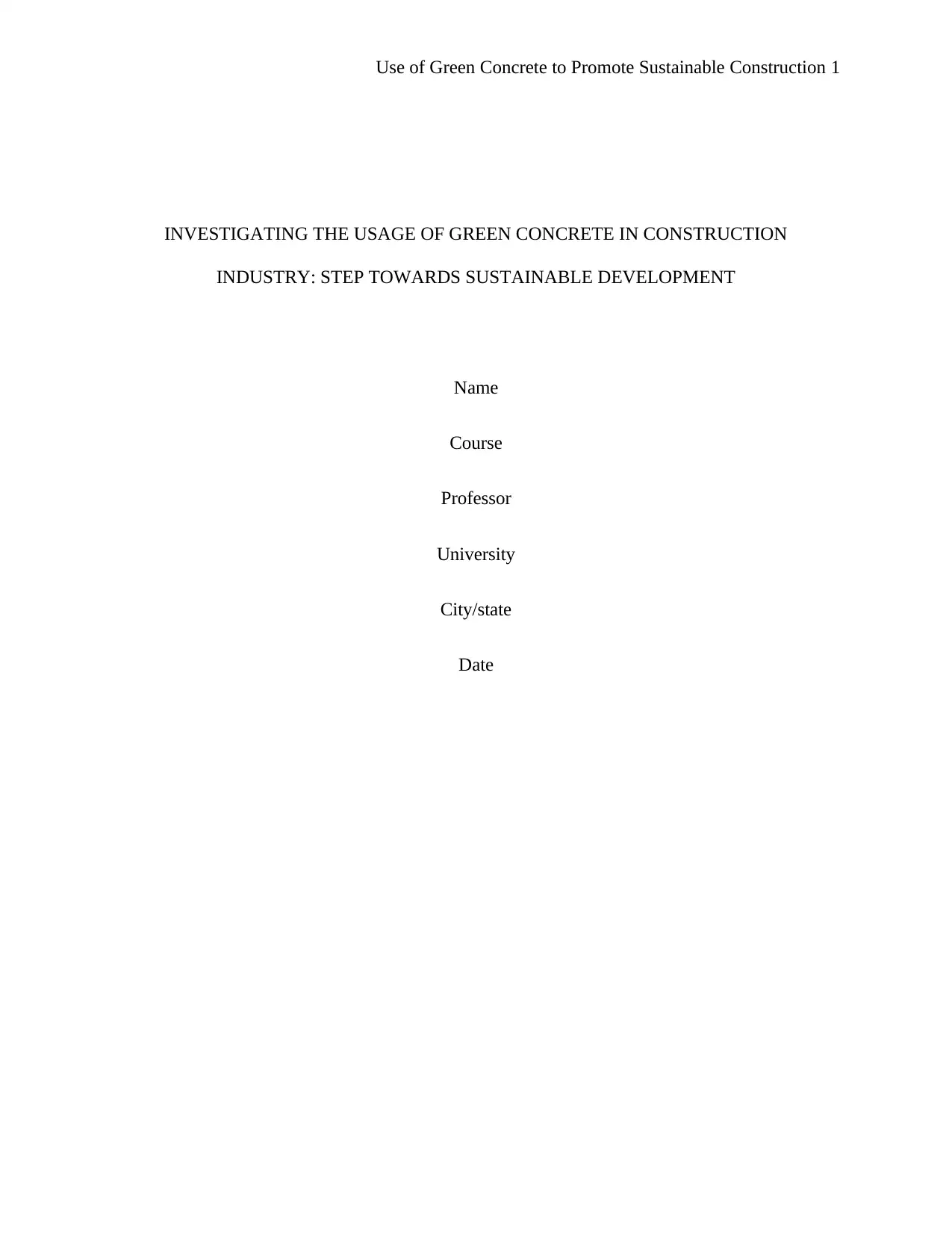
Use of Green Concrete to Promote Sustainable Construction 1
INVESTIGATING THE USAGE OF GREEN CONCRETE IN CONSTRUCTION
INDUSTRY: STEP TOWARDS SUSTAINABLE DEVELOPMENT
Name
Course
Professor
University
City/state
Date
INVESTIGATING THE USAGE OF GREEN CONCRETE IN CONSTRUCTION
INDUSTRY: STEP TOWARDS SUSTAINABLE DEVELOPMENT
Name
Course
Professor
University
City/state
Date
Paraphrase This Document
Need a fresh take? Get an instant paraphrase of this document with our AI Paraphraser
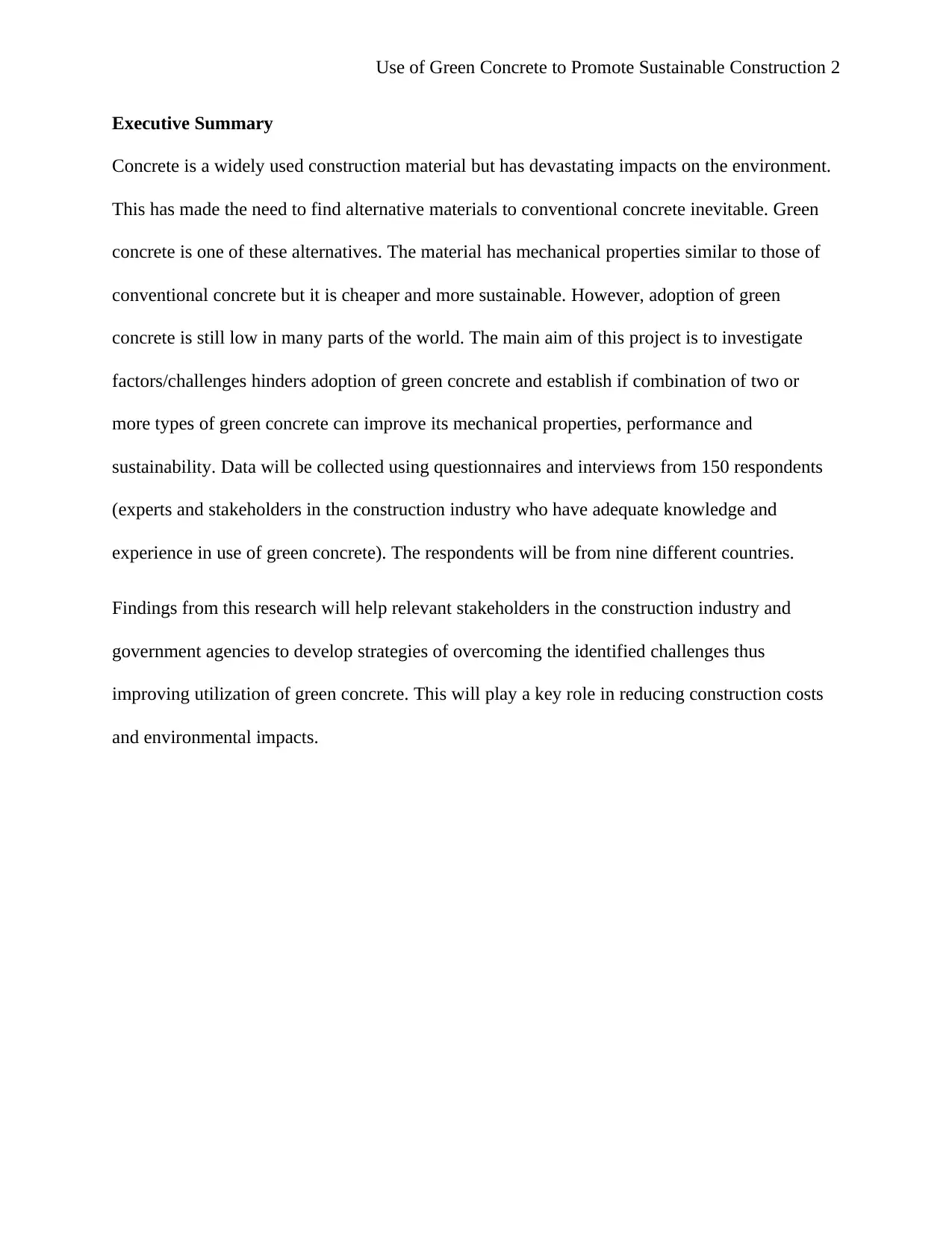
Use of Green Concrete to Promote Sustainable Construction 2
Executive Summary
Concrete is a widely used construction material but has devastating impacts on the environment.
This has made the need to find alternative materials to conventional concrete inevitable. Green
concrete is one of these alternatives. The material has mechanical properties similar to those of
conventional concrete but it is cheaper and more sustainable. However, adoption of green
concrete is still low in many parts of the world. The main aim of this project is to investigate
factors/challenges hinders adoption of green concrete and establish if combination of two or
more types of green concrete can improve its mechanical properties, performance and
sustainability. Data will be collected using questionnaires and interviews from 150 respondents
(experts and stakeholders in the construction industry who have adequate knowledge and
experience in use of green concrete). The respondents will be from nine different countries.
Findings from this research will help relevant stakeholders in the construction industry and
government agencies to develop strategies of overcoming the identified challenges thus
improving utilization of green concrete. This will play a key role in reducing construction costs
and environmental impacts.
Executive Summary
Concrete is a widely used construction material but has devastating impacts on the environment.
This has made the need to find alternative materials to conventional concrete inevitable. Green
concrete is one of these alternatives. The material has mechanical properties similar to those of
conventional concrete but it is cheaper and more sustainable. However, adoption of green
concrete is still low in many parts of the world. The main aim of this project is to investigate
factors/challenges hinders adoption of green concrete and establish if combination of two or
more types of green concrete can improve its mechanical properties, performance and
sustainability. Data will be collected using questionnaires and interviews from 150 respondents
(experts and stakeholders in the construction industry who have adequate knowledge and
experience in use of green concrete). The respondents will be from nine different countries.
Findings from this research will help relevant stakeholders in the construction industry and
government agencies to develop strategies of overcoming the identified challenges thus
improving utilization of green concrete. This will play a key role in reducing construction costs
and environmental impacts.
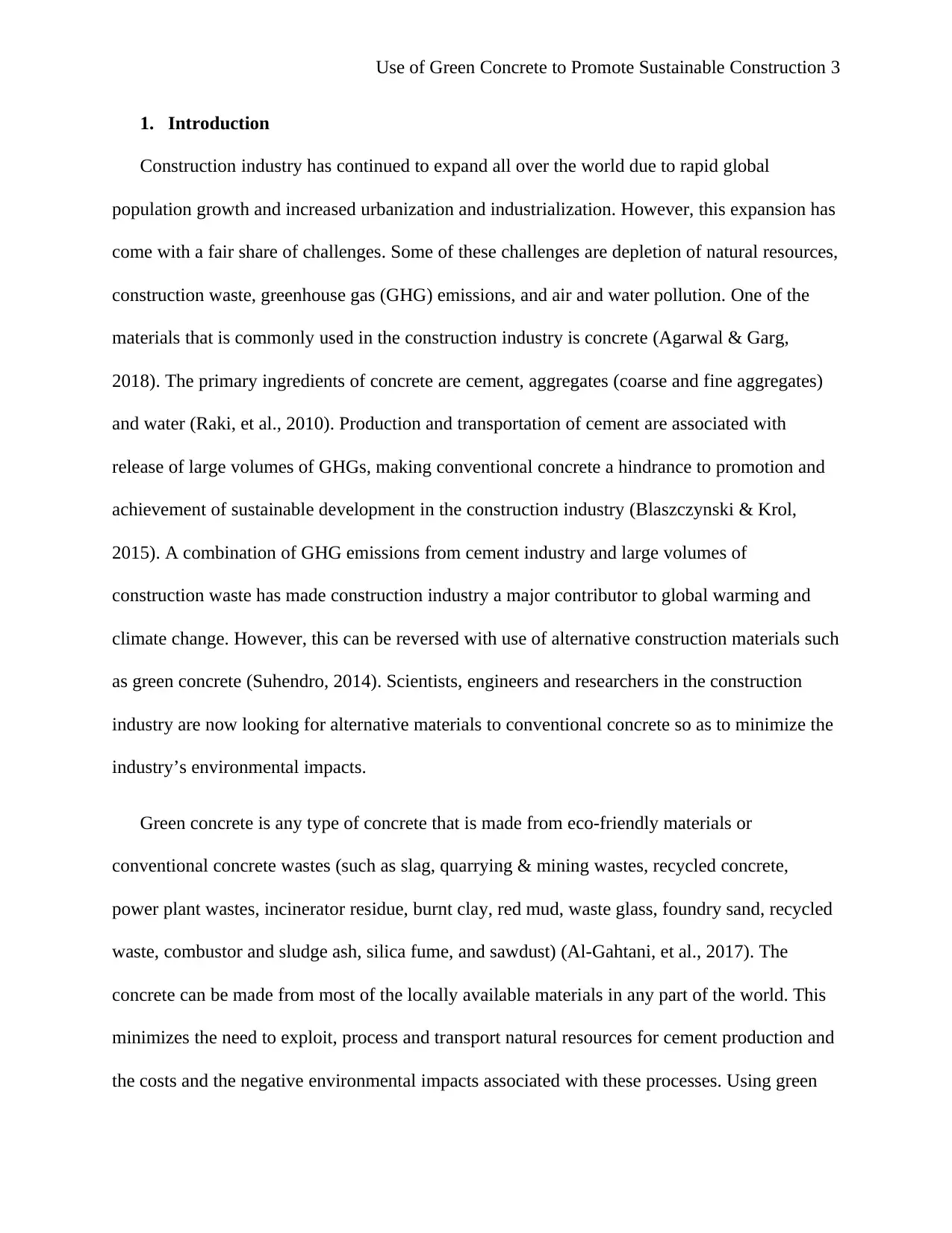
Use of Green Concrete to Promote Sustainable Construction 3
1. Introduction
Construction industry has continued to expand all over the world due to rapid global
population growth and increased urbanization and industrialization. However, this expansion has
come with a fair share of challenges. Some of these challenges are depletion of natural resources,
construction waste, greenhouse gas (GHG) emissions, and air and water pollution. One of the
materials that is commonly used in the construction industry is concrete (Agarwal & Garg,
2018). The primary ingredients of concrete are cement, aggregates (coarse and fine aggregates)
and water (Raki, et al., 2010). Production and transportation of cement are associated with
release of large volumes of GHGs, making conventional concrete a hindrance to promotion and
achievement of sustainable development in the construction industry (Blaszczynski & Krol,
2015). A combination of GHG emissions from cement industry and large volumes of
construction waste has made construction industry a major contributor to global warming and
climate change. However, this can be reversed with use of alternative construction materials such
as green concrete (Suhendro, 2014). Scientists, engineers and researchers in the construction
industry are now looking for alternative materials to conventional concrete so as to minimize the
industry’s environmental impacts.
Green concrete is any type of concrete that is made from eco-friendly materials or
conventional concrete wastes (such as slag, quarrying & mining wastes, recycled concrete,
power plant wastes, incinerator residue, burnt clay, red mud, waste glass, foundry sand, recycled
waste, combustor and sludge ash, silica fume, and sawdust) (Al-Gahtani, et al., 2017). The
concrete can be made from most of the locally available materials in any part of the world. This
minimizes the need to exploit, process and transport natural resources for cement production and
the costs and the negative environmental impacts associated with these processes. Using green
1. Introduction
Construction industry has continued to expand all over the world due to rapid global
population growth and increased urbanization and industrialization. However, this expansion has
come with a fair share of challenges. Some of these challenges are depletion of natural resources,
construction waste, greenhouse gas (GHG) emissions, and air and water pollution. One of the
materials that is commonly used in the construction industry is concrete (Agarwal & Garg,
2018). The primary ingredients of concrete are cement, aggregates (coarse and fine aggregates)
and water (Raki, et al., 2010). Production and transportation of cement are associated with
release of large volumes of GHGs, making conventional concrete a hindrance to promotion and
achievement of sustainable development in the construction industry (Blaszczynski & Krol,
2015). A combination of GHG emissions from cement industry and large volumes of
construction waste has made construction industry a major contributor to global warming and
climate change. However, this can be reversed with use of alternative construction materials such
as green concrete (Suhendro, 2014). Scientists, engineers and researchers in the construction
industry are now looking for alternative materials to conventional concrete so as to minimize the
industry’s environmental impacts.
Green concrete is any type of concrete that is made from eco-friendly materials or
conventional concrete wastes (such as slag, quarrying & mining wastes, recycled concrete,
power plant wastes, incinerator residue, burnt clay, red mud, waste glass, foundry sand, recycled
waste, combustor and sludge ash, silica fume, and sawdust) (Al-Gahtani, et al., 2017). The
concrete can be made from most of the locally available materials in any part of the world. This
minimizes the need to exploit, process and transport natural resources for cement production and
the costs and the negative environmental impacts associated with these processes. Using green
⊘ This is a preview!⊘
Do you want full access?
Subscribe today to unlock all pages.

Trusted by 1+ million students worldwide
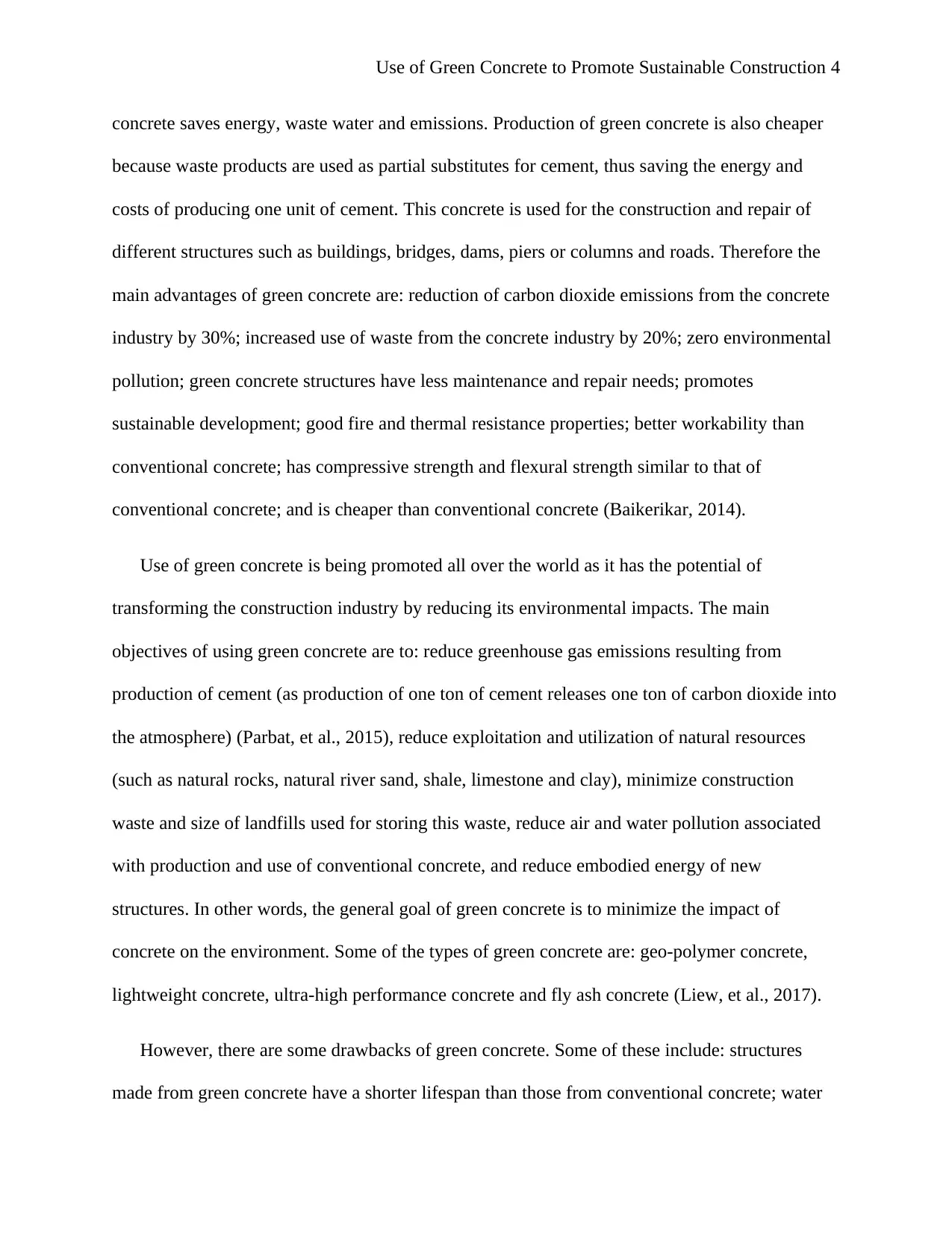
Use of Green Concrete to Promote Sustainable Construction 4
concrete saves energy, waste water and emissions. Production of green concrete is also cheaper
because waste products are used as partial substitutes for cement, thus saving the energy and
costs of producing one unit of cement. This concrete is used for the construction and repair of
different structures such as buildings, bridges, dams, piers or columns and roads. Therefore the
main advantages of green concrete are: reduction of carbon dioxide emissions from the concrete
industry by 30%; increased use of waste from the concrete industry by 20%; zero environmental
pollution; green concrete structures have less maintenance and repair needs; promotes
sustainable development; good fire and thermal resistance properties; better workability than
conventional concrete; has compressive strength and flexural strength similar to that of
conventional concrete; and is cheaper than conventional concrete (Baikerikar, 2014).
Use of green concrete is being promoted all over the world as it has the potential of
transforming the construction industry by reducing its environmental impacts. The main
objectives of using green concrete are to: reduce greenhouse gas emissions resulting from
production of cement (as production of one ton of cement releases one ton of carbon dioxide into
the atmosphere) (Parbat, et al., 2015), reduce exploitation and utilization of natural resources
(such as natural rocks, natural river sand, shale, limestone and clay), minimize construction
waste and size of landfills used for storing this waste, reduce air and water pollution associated
with production and use of conventional concrete, and reduce embodied energy of new
structures. In other words, the general goal of green concrete is to minimize the impact of
concrete on the environment. Some of the types of green concrete are: geo-polymer concrete,
lightweight concrete, ultra-high performance concrete and fly ash concrete (Liew, et al., 2017).
However, there are some drawbacks of green concrete. Some of these include: structures
made from green concrete have a shorter lifespan than those from conventional concrete; water
concrete saves energy, waste water and emissions. Production of green concrete is also cheaper
because waste products are used as partial substitutes for cement, thus saving the energy and
costs of producing one unit of cement. This concrete is used for the construction and repair of
different structures such as buildings, bridges, dams, piers or columns and roads. Therefore the
main advantages of green concrete are: reduction of carbon dioxide emissions from the concrete
industry by 30%; increased use of waste from the concrete industry by 20%; zero environmental
pollution; green concrete structures have less maintenance and repair needs; promotes
sustainable development; good fire and thermal resistance properties; better workability than
conventional concrete; has compressive strength and flexural strength similar to that of
conventional concrete; and is cheaper than conventional concrete (Baikerikar, 2014).
Use of green concrete is being promoted all over the world as it has the potential of
transforming the construction industry by reducing its environmental impacts. The main
objectives of using green concrete are to: reduce greenhouse gas emissions resulting from
production of cement (as production of one ton of cement releases one ton of carbon dioxide into
the atmosphere) (Parbat, et al., 2015), reduce exploitation and utilization of natural resources
(such as natural rocks, natural river sand, shale, limestone and clay), minimize construction
waste and size of landfills used for storing this waste, reduce air and water pollution associated
with production and use of conventional concrete, and reduce embodied energy of new
structures. In other words, the general goal of green concrete is to minimize the impact of
concrete on the environment. Some of the types of green concrete are: geo-polymer concrete,
lightweight concrete, ultra-high performance concrete and fly ash concrete (Liew, et al., 2017).
However, there are some drawbacks of green concrete. Some of these include: structures
made from green concrete have a shorter lifespan than those from conventional concrete; water
Paraphrase This Document
Need a fresh take? Get an instant paraphrase of this document with our AI Paraphraser
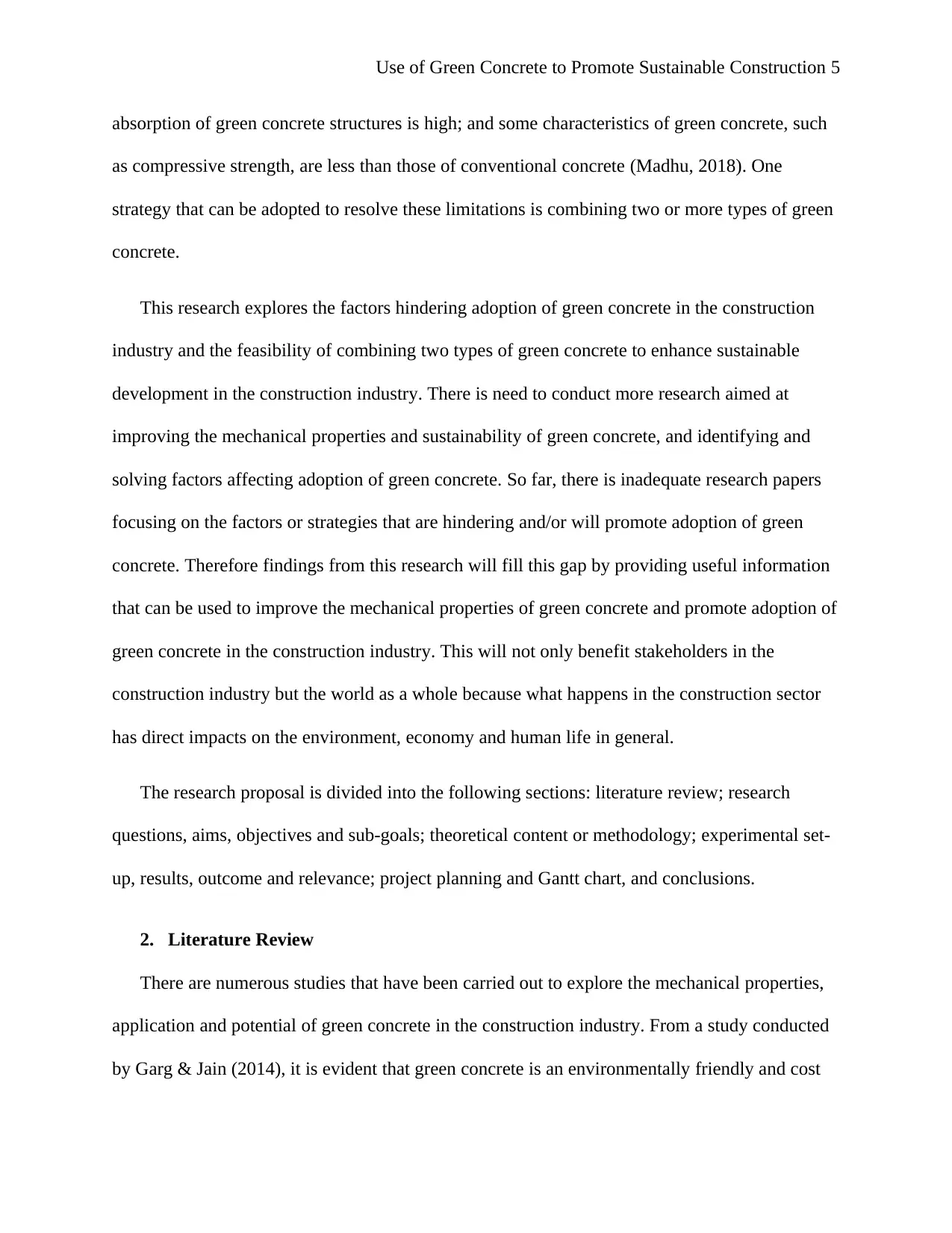
Use of Green Concrete to Promote Sustainable Construction 5
absorption of green concrete structures is high; and some characteristics of green concrete, such
as compressive strength, are less than those of conventional concrete (Madhu, 2018). One
strategy that can be adopted to resolve these limitations is combining two or more types of green
concrete.
This research explores the factors hindering adoption of green concrete in the construction
industry and the feasibility of combining two types of green concrete to enhance sustainable
development in the construction industry. There is need to conduct more research aimed at
improving the mechanical properties and sustainability of green concrete, and identifying and
solving factors affecting adoption of green concrete. So far, there is inadequate research papers
focusing on the factors or strategies that are hindering and/or will promote adoption of green
concrete. Therefore findings from this research will fill this gap by providing useful information
that can be used to improve the mechanical properties of green concrete and promote adoption of
green concrete in the construction industry. This will not only benefit stakeholders in the
construction industry but the world as a whole because what happens in the construction sector
has direct impacts on the environment, economy and human life in general.
The research proposal is divided into the following sections: literature review; research
questions, aims, objectives and sub-goals; theoretical content or methodology; experimental set-
up, results, outcome and relevance; project planning and Gantt chart, and conclusions.
2. Literature Review
There are numerous studies that have been carried out to explore the mechanical properties,
application and potential of green concrete in the construction industry. From a study conducted
by Garg & Jain (2014), it is evident that green concrete is an environmentally friendly and cost
absorption of green concrete structures is high; and some characteristics of green concrete, such
as compressive strength, are less than those of conventional concrete (Madhu, 2018). One
strategy that can be adopted to resolve these limitations is combining two or more types of green
concrete.
This research explores the factors hindering adoption of green concrete in the construction
industry and the feasibility of combining two types of green concrete to enhance sustainable
development in the construction industry. There is need to conduct more research aimed at
improving the mechanical properties and sustainability of green concrete, and identifying and
solving factors affecting adoption of green concrete. So far, there is inadequate research papers
focusing on the factors or strategies that are hindering and/or will promote adoption of green
concrete. Therefore findings from this research will fill this gap by providing useful information
that can be used to improve the mechanical properties of green concrete and promote adoption of
green concrete in the construction industry. This will not only benefit stakeholders in the
construction industry but the world as a whole because what happens in the construction sector
has direct impacts on the environment, economy and human life in general.
The research proposal is divided into the following sections: literature review; research
questions, aims, objectives and sub-goals; theoretical content or methodology; experimental set-
up, results, outcome and relevance; project planning and Gantt chart, and conclusions.
2. Literature Review
There are numerous studies that have been carried out to explore the mechanical properties,
application and potential of green concrete in the construction industry. From a study conducted
by Garg & Jain (2014), it is evident that green concrete is an environmentally friendly and cost
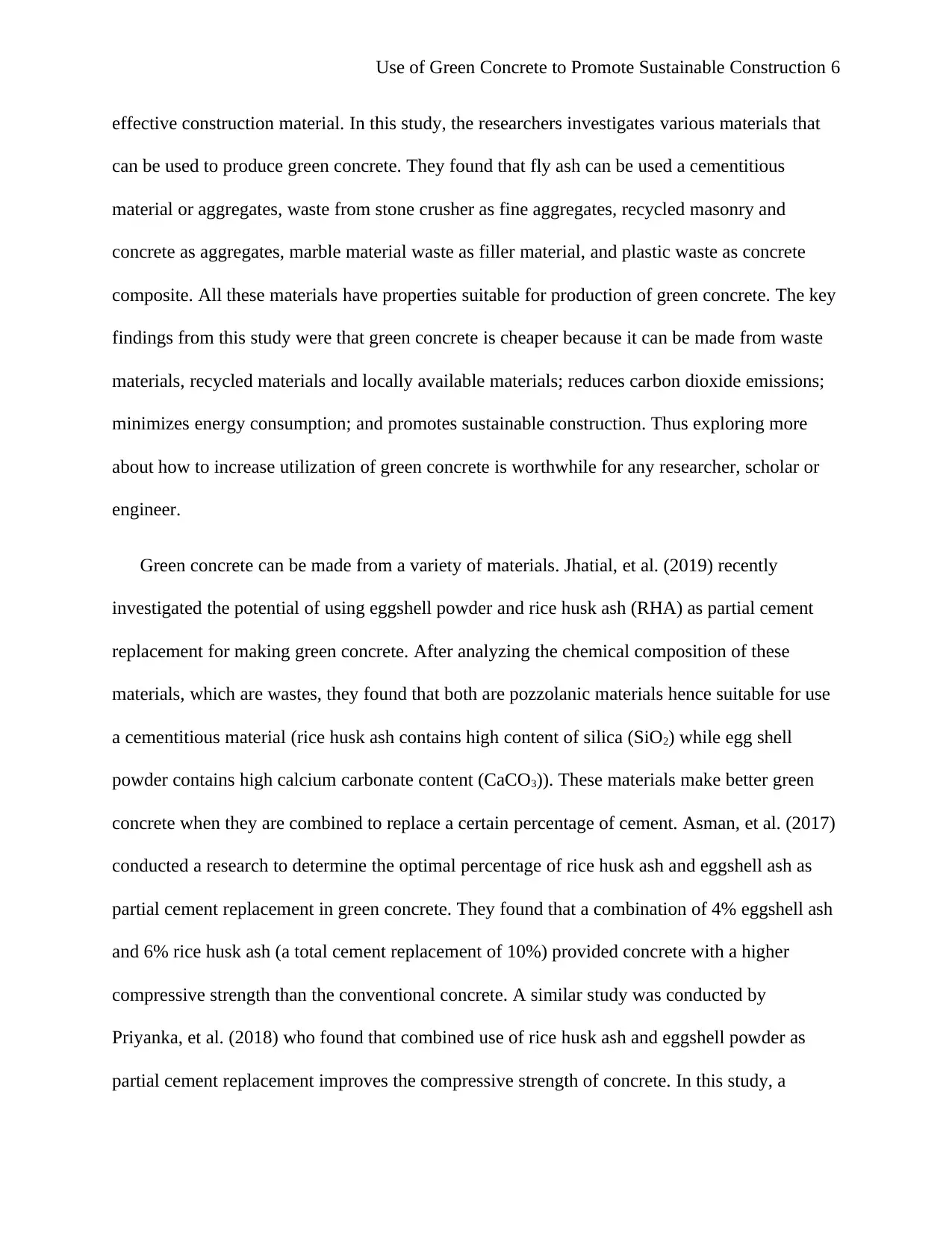
Use of Green Concrete to Promote Sustainable Construction 6
effective construction material. In this study, the researchers investigates various materials that
can be used to produce green concrete. They found that fly ash can be used a cementitious
material or aggregates, waste from stone crusher as fine aggregates, recycled masonry and
concrete as aggregates, marble material waste as filler material, and plastic waste as concrete
composite. All these materials have properties suitable for production of green concrete. The key
findings from this study were that green concrete is cheaper because it can be made from waste
materials, recycled materials and locally available materials; reduces carbon dioxide emissions;
minimizes energy consumption; and promotes sustainable construction. Thus exploring more
about how to increase utilization of green concrete is worthwhile for any researcher, scholar or
engineer.
Green concrete can be made from a variety of materials. Jhatial, et al. (2019) recently
investigated the potential of using eggshell powder and rice husk ash (RHA) as partial cement
replacement for making green concrete. After analyzing the chemical composition of these
materials, which are wastes, they found that both are pozzolanic materials hence suitable for use
a cementitious material (rice husk ash contains high content of silica (SiO2) while egg shell
powder contains high calcium carbonate content (CaCO3)). These materials make better green
concrete when they are combined to replace a certain percentage of cement. Asman, et al. (2017)
conducted a research to determine the optimal percentage of rice husk ash and eggshell ash as
partial cement replacement in green concrete. They found that a combination of 4% eggshell ash
and 6% rice husk ash (a total cement replacement of 10%) provided concrete with a higher
compressive strength than the conventional concrete. A similar study was conducted by
Priyanka, et al. (2018) who found that combined use of rice husk ash and eggshell powder as
partial cement replacement improves the compressive strength of concrete. In this study, a
effective construction material. In this study, the researchers investigates various materials that
can be used to produce green concrete. They found that fly ash can be used a cementitious
material or aggregates, waste from stone crusher as fine aggregates, recycled masonry and
concrete as aggregates, marble material waste as filler material, and plastic waste as concrete
composite. All these materials have properties suitable for production of green concrete. The key
findings from this study were that green concrete is cheaper because it can be made from waste
materials, recycled materials and locally available materials; reduces carbon dioxide emissions;
minimizes energy consumption; and promotes sustainable construction. Thus exploring more
about how to increase utilization of green concrete is worthwhile for any researcher, scholar or
engineer.
Green concrete can be made from a variety of materials. Jhatial, et al. (2019) recently
investigated the potential of using eggshell powder and rice husk ash (RHA) as partial cement
replacement for making green concrete. After analyzing the chemical composition of these
materials, which are wastes, they found that both are pozzolanic materials hence suitable for use
a cementitious material (rice husk ash contains high content of silica (SiO2) while egg shell
powder contains high calcium carbonate content (CaCO3)). These materials make better green
concrete when they are combined to replace a certain percentage of cement. Asman, et al. (2017)
conducted a research to determine the optimal percentage of rice husk ash and eggshell ash as
partial cement replacement in green concrete. They found that a combination of 4% eggshell ash
and 6% rice husk ash (a total cement replacement of 10%) provided concrete with a higher
compressive strength than the conventional concrete. A similar study was conducted by
Priyanka, et al. (2018) who found that combined use of rice husk ash and eggshell powder as
partial cement replacement improves the compressive strength of concrete. In this study, a
⊘ This is a preview!⊘
Do you want full access?
Subscribe today to unlock all pages.

Trusted by 1+ million students worldwide

Use of Green Concrete to Promote Sustainable Construction 7
combination of 15% rice husk ash and 5% eggshell power (a total cement replacement of 20%)
provided concrete with a compressive strength of 38.67 MPa after 28 days of curing, which was
22.72% higher than that of the conventional concrete.
Nevertheless, the flexural and tensile strengths of the concrete made using a combination of
rice husk ash and eggshell ash from both studies were slightly lower than those of conventional
concrete. Thus it can be concluded from these studies that green concrete with higher
compressive strength can be made from a combination of rice husk ash and eggshell ash as
partial cement replacement but the concrete will have lower flexural and tensile strengths. This
makes it necessary to conduct more research so as to determine the optimal combination of
materials or types of green concrete that will produce concrete with higher compressive, tensile
and flexural strengths, which is the basis of this project.
Attanasio, et al. (2018) carried out a study to identify some of the challenges faced when
using green concrete. They investigated a project, SUS-Con project, which was aimed at
integrating secondary raw materials in the production of green concrete. This was a four-year
project funded by EU and was completed successfully in 2015. In this project, green concrete
was made from recycled aggregates (mixed plastic scraps, electrical and electronic plastics,
waste polyurethane foams and end-of-life tyres) and low carbon limy galvanized binders. A pilot
building was constructed using the green concrete and various properties tested, including
mechanical, fire resistance and insulation properties. They also monitored energy efficiency
performances of the pilot building. It was found from this study that use of green concrete
significantly reduces global warming potential (GWP), embodied energy, cost, and safety &
health risks. However, the researchers discovered that implementation of such projects in the EU
countries was largely hindered by lack of harmonized standards and regulations. This means that
combination of 15% rice husk ash and 5% eggshell power (a total cement replacement of 20%)
provided concrete with a compressive strength of 38.67 MPa after 28 days of curing, which was
22.72% higher than that of the conventional concrete.
Nevertheless, the flexural and tensile strengths of the concrete made using a combination of
rice husk ash and eggshell ash from both studies were slightly lower than those of conventional
concrete. Thus it can be concluded from these studies that green concrete with higher
compressive strength can be made from a combination of rice husk ash and eggshell ash as
partial cement replacement but the concrete will have lower flexural and tensile strengths. This
makes it necessary to conduct more research so as to determine the optimal combination of
materials or types of green concrete that will produce concrete with higher compressive, tensile
and flexural strengths, which is the basis of this project.
Attanasio, et al. (2018) carried out a study to identify some of the challenges faced when
using green concrete. They investigated a project, SUS-Con project, which was aimed at
integrating secondary raw materials in the production of green concrete. This was a four-year
project funded by EU and was completed successfully in 2015. In this project, green concrete
was made from recycled aggregates (mixed plastic scraps, electrical and electronic plastics,
waste polyurethane foams and end-of-life tyres) and low carbon limy galvanized binders. A pilot
building was constructed using the green concrete and various properties tested, including
mechanical, fire resistance and insulation properties. They also monitored energy efficiency
performances of the pilot building. It was found from this study that use of green concrete
significantly reduces global warming potential (GWP), embodied energy, cost, and safety &
health risks. However, the researchers discovered that implementation of such projects in the EU
countries was largely hindered by lack of harmonized standards and regulations. This means that
Paraphrase This Document
Need a fresh take? Get an instant paraphrase of this document with our AI Paraphraser
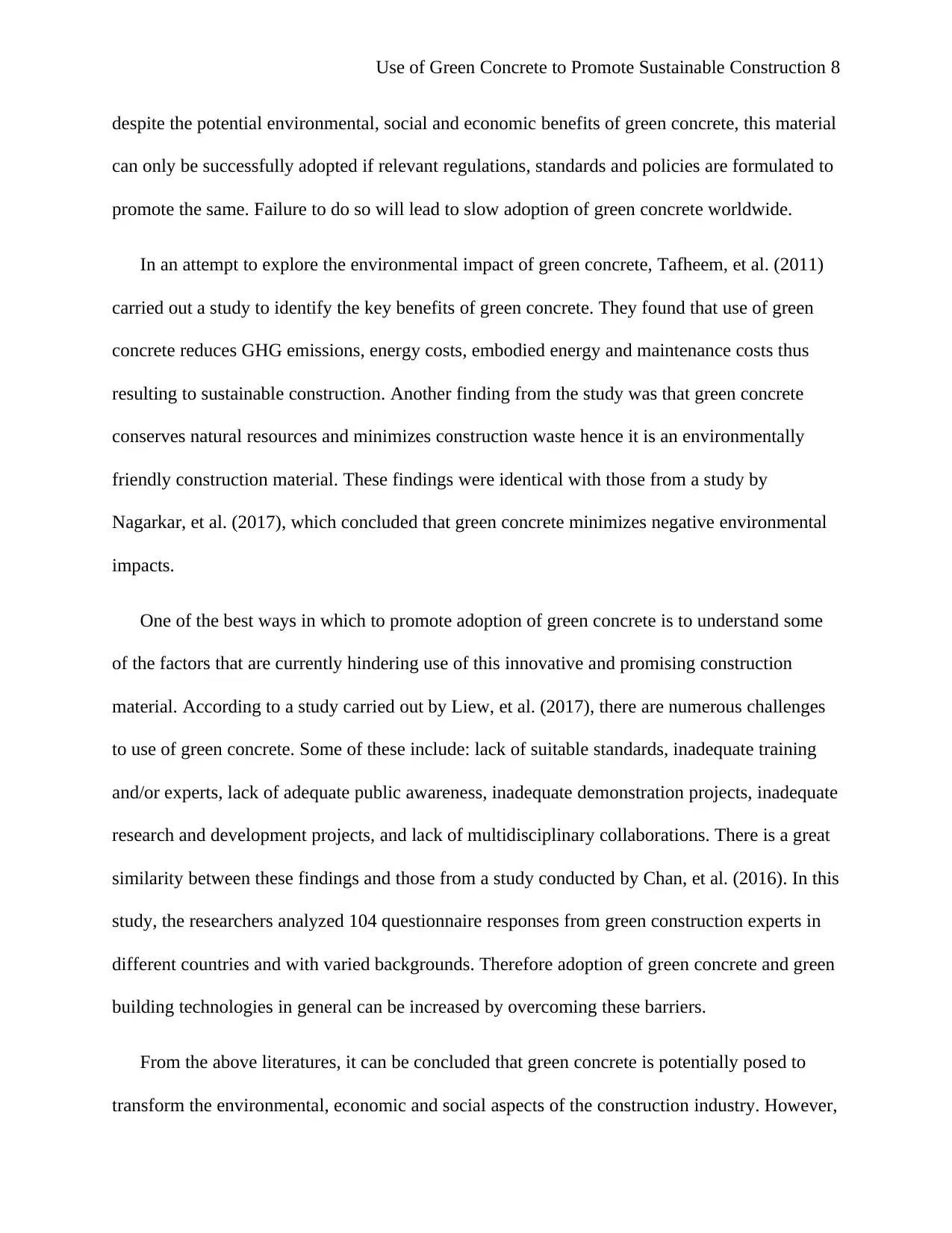
Use of Green Concrete to Promote Sustainable Construction 8
despite the potential environmental, social and economic benefits of green concrete, this material
can only be successfully adopted if relevant regulations, standards and policies are formulated to
promote the same. Failure to do so will lead to slow adoption of green concrete worldwide.
In an attempt to explore the environmental impact of green concrete, Tafheem, et al. (2011)
carried out a study to identify the key benefits of green concrete. They found that use of green
concrete reduces GHG emissions, energy costs, embodied energy and maintenance costs thus
resulting to sustainable construction. Another finding from the study was that green concrete
conserves natural resources and minimizes construction waste hence it is an environmentally
friendly construction material. These findings were identical with those from a study by
Nagarkar, et al. (2017), which concluded that green concrete minimizes negative environmental
impacts.
One of the best ways in which to promote adoption of green concrete is to understand some
of the factors that are currently hindering use of this innovative and promising construction
material. According to a study carried out by Liew, et al. (2017), there are numerous challenges
to use of green concrete. Some of these include: lack of suitable standards, inadequate training
and/or experts, lack of adequate public awareness, inadequate demonstration projects, inadequate
research and development projects, and lack of multidisciplinary collaborations. There is a great
similarity between these findings and those from a study conducted by Chan, et al. (2016). In this
study, the researchers analyzed 104 questionnaire responses from green construction experts in
different countries and with varied backgrounds. Therefore adoption of green concrete and green
building technologies in general can be increased by overcoming these barriers.
From the above literatures, it can be concluded that green concrete is potentially posed to
transform the environmental, economic and social aspects of the construction industry. However,
despite the potential environmental, social and economic benefits of green concrete, this material
can only be successfully adopted if relevant regulations, standards and policies are formulated to
promote the same. Failure to do so will lead to slow adoption of green concrete worldwide.
In an attempt to explore the environmental impact of green concrete, Tafheem, et al. (2011)
carried out a study to identify the key benefits of green concrete. They found that use of green
concrete reduces GHG emissions, energy costs, embodied energy and maintenance costs thus
resulting to sustainable construction. Another finding from the study was that green concrete
conserves natural resources and minimizes construction waste hence it is an environmentally
friendly construction material. These findings were identical with those from a study by
Nagarkar, et al. (2017), which concluded that green concrete minimizes negative environmental
impacts.
One of the best ways in which to promote adoption of green concrete is to understand some
of the factors that are currently hindering use of this innovative and promising construction
material. According to a study carried out by Liew, et al. (2017), there are numerous challenges
to use of green concrete. Some of these include: lack of suitable standards, inadequate training
and/or experts, lack of adequate public awareness, inadequate demonstration projects, inadequate
research and development projects, and lack of multidisciplinary collaborations. There is a great
similarity between these findings and those from a study conducted by Chan, et al. (2016). In this
study, the researchers analyzed 104 questionnaire responses from green construction experts in
different countries and with varied backgrounds. Therefore adoption of green concrete and green
building technologies in general can be increased by overcoming these barriers.
From the above literatures, it can be concluded that green concrete is potentially posed to
transform the environmental, economic and social aspects of the construction industry. However,

Use of Green Concrete to Promote Sustainable Construction 9
this can only be achieved if more research is done to identify a combination of different types of
green concrete that will overcome the drawbacks of individual types of green concrete. More
research is also needed to pinpoint the specific hindrances to adoption of green concrete and
develop their solutions.
3. Research Question(s), Aim, Objectives and Sub-goals
3.1. Research Questions
The key research questions in this project are as follows:
1. What are the real benefits of using green concrete?
2. What are the disadvantages of using green concrete?
3. What are the factors or challenges hindering adoption of green concrete in the
construction industry?
4. Does utilization of green concrete promote sustainable development in the construction
industry?
5. How can adoption of green concrete in the construction industry be promoted or
improved?
6. What are the most suitable types of green concrete?
7. Can combination of two or more types of green concrete improve sustainable
development in the construction industry?
3.2. Aim
This project aims at investigating the factors hindering adoption of green concrete in the
construction industry, the potential of green concrete in promoting sustainable construction, and
if combination of two or more types of green concrete can help in improving essential
this can only be achieved if more research is done to identify a combination of different types of
green concrete that will overcome the drawbacks of individual types of green concrete. More
research is also needed to pinpoint the specific hindrances to adoption of green concrete and
develop their solutions.
3. Research Question(s), Aim, Objectives and Sub-goals
3.1. Research Questions
The key research questions in this project are as follows:
1. What are the real benefits of using green concrete?
2. What are the disadvantages of using green concrete?
3. What are the factors or challenges hindering adoption of green concrete in the
construction industry?
4. Does utilization of green concrete promote sustainable development in the construction
industry?
5. How can adoption of green concrete in the construction industry be promoted or
improved?
6. What are the most suitable types of green concrete?
7. Can combination of two or more types of green concrete improve sustainable
development in the construction industry?
3.2. Aim
This project aims at investigating the factors hindering adoption of green concrete in the
construction industry, the potential of green concrete in promoting sustainable construction, and
if combination of two or more types of green concrete can help in improving essential
⊘ This is a preview!⊘
Do you want full access?
Subscribe today to unlock all pages.

Trusted by 1+ million students worldwide
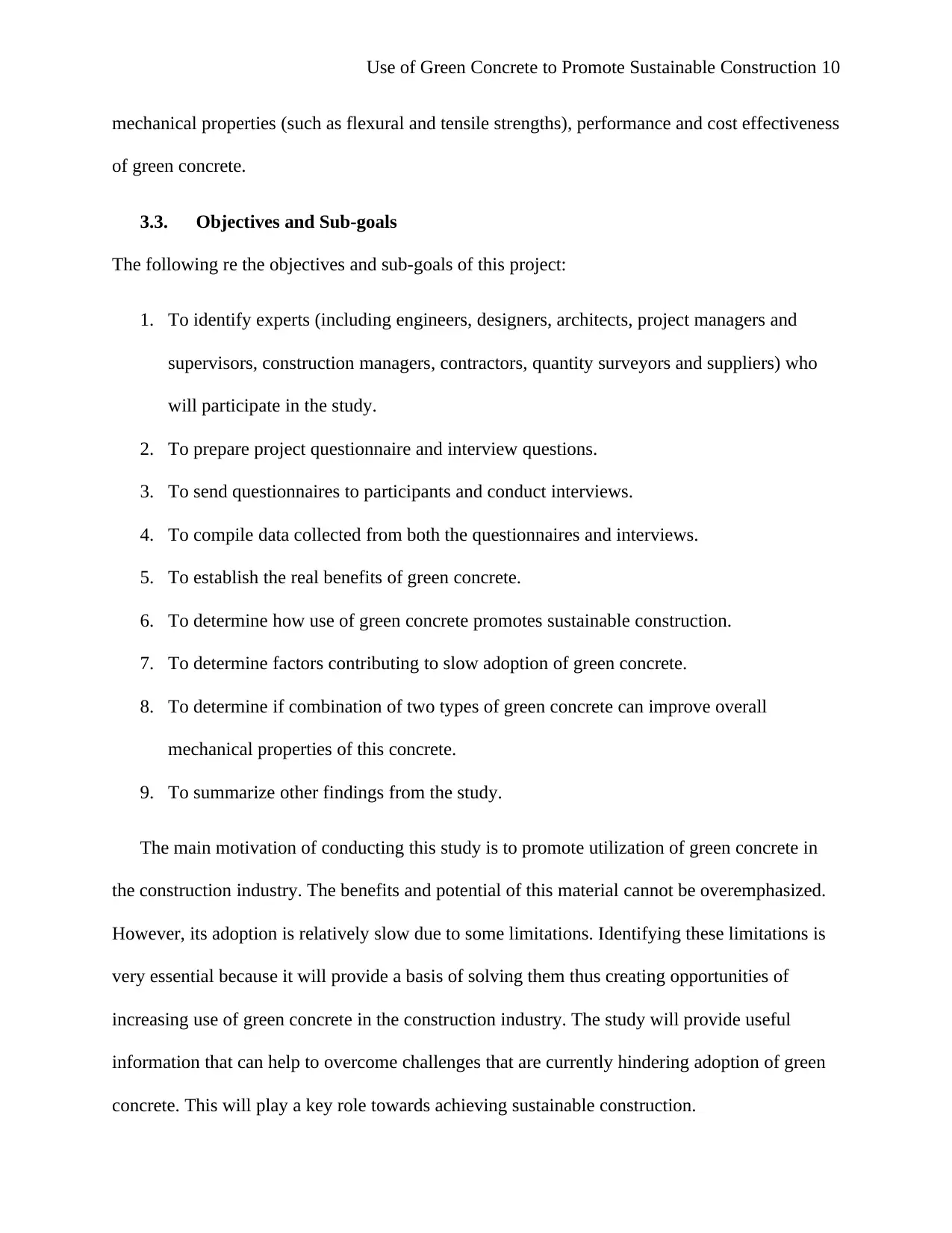
Use of Green Concrete to Promote Sustainable Construction 10
mechanical properties (such as flexural and tensile strengths), performance and cost effectiveness
of green concrete.
3.3. Objectives and Sub-goals
The following re the objectives and sub-goals of this project:
1. To identify experts (including engineers, designers, architects, project managers and
supervisors, construction managers, contractors, quantity surveyors and suppliers) who
will participate in the study.
2. To prepare project questionnaire and interview questions.
3. To send questionnaires to participants and conduct interviews.
4. To compile data collected from both the questionnaires and interviews.
5. To establish the real benefits of green concrete.
6. To determine how use of green concrete promotes sustainable construction.
7. To determine factors contributing to slow adoption of green concrete.
8. To determine if combination of two types of green concrete can improve overall
mechanical properties of this concrete.
9. To summarize other findings from the study.
The main motivation of conducting this study is to promote utilization of green concrete in
the construction industry. The benefits and potential of this material cannot be overemphasized.
However, its adoption is relatively slow due to some limitations. Identifying these limitations is
very essential because it will provide a basis of solving them thus creating opportunities of
increasing use of green concrete in the construction industry. The study will provide useful
information that can help to overcome challenges that are currently hindering adoption of green
concrete. This will play a key role towards achieving sustainable construction.
mechanical properties (such as flexural and tensile strengths), performance and cost effectiveness
of green concrete.
3.3. Objectives and Sub-goals
The following re the objectives and sub-goals of this project:
1. To identify experts (including engineers, designers, architects, project managers and
supervisors, construction managers, contractors, quantity surveyors and suppliers) who
will participate in the study.
2. To prepare project questionnaire and interview questions.
3. To send questionnaires to participants and conduct interviews.
4. To compile data collected from both the questionnaires and interviews.
5. To establish the real benefits of green concrete.
6. To determine how use of green concrete promotes sustainable construction.
7. To determine factors contributing to slow adoption of green concrete.
8. To determine if combination of two types of green concrete can improve overall
mechanical properties of this concrete.
9. To summarize other findings from the study.
The main motivation of conducting this study is to promote utilization of green concrete in
the construction industry. The benefits and potential of this material cannot be overemphasized.
However, its adoption is relatively slow due to some limitations. Identifying these limitations is
very essential because it will provide a basis of solving them thus creating opportunities of
increasing use of green concrete in the construction industry. The study will provide useful
information that can help to overcome challenges that are currently hindering adoption of green
concrete. This will play a key role towards achieving sustainable construction.
Paraphrase This Document
Need a fresh take? Get an instant paraphrase of this document with our AI Paraphraser

Use of Green Concrete to Promote Sustainable Construction 11
4. Theoretical Content/Methodology
Concrete is commonly used in most of the construction projects because of its
mechanical properties. These properties include compressive strength, modulus of elasticity,
tensile strength, flexural strength and greater capacity to resist a variety of environmental and
loading conditions. Cement is the main ingredient that binds all other components of concrete.
However, increased demand for mass production of cement has resulted to exploitation of natural
resources and increase emission of GHGs. Most of the activities associated with cement
production use large amounts of non-renewable energy thus affecting the environment
negatively. This also continues to contribute to global warming and climate change. As the world
continues with efforts to fight global warming and climate change, stakeholders in the
construction industry have discovered that green concrete can be used as an alternative to
conventional concrete. The green concrete is made from environmentally friendlier and cheaper
ingredients. For example, rice husk ash and eggshell ash can be used to replace 20% of cement in
concrete. This reduction in cement content also reduces the cost and GHG emissions associated
with making one unit of concrete. Several studies have been conducted and proved that proper
combination of alternative materials can produce green concrete of comprehensive strength
similar to or higher than that of conventional concrete.
It is also worth noting that there are different types of green concrete, each with its
strengths and weaknesses. Combining two or more types of green concrete can also be one way
of improving the mechanical properties and advantages of green concrete. However, adoption of
green concrete is still slow in most parts of the world and it is due to some challenges.
Identifying and finding solutions to these challenges will largely improve adoption of green
concrete.
4. Theoretical Content/Methodology
Concrete is commonly used in most of the construction projects because of its
mechanical properties. These properties include compressive strength, modulus of elasticity,
tensile strength, flexural strength and greater capacity to resist a variety of environmental and
loading conditions. Cement is the main ingredient that binds all other components of concrete.
However, increased demand for mass production of cement has resulted to exploitation of natural
resources and increase emission of GHGs. Most of the activities associated with cement
production use large amounts of non-renewable energy thus affecting the environment
negatively. This also continues to contribute to global warming and climate change. As the world
continues with efforts to fight global warming and climate change, stakeholders in the
construction industry have discovered that green concrete can be used as an alternative to
conventional concrete. The green concrete is made from environmentally friendlier and cheaper
ingredients. For example, rice husk ash and eggshell ash can be used to replace 20% of cement in
concrete. This reduction in cement content also reduces the cost and GHG emissions associated
with making one unit of concrete. Several studies have been conducted and proved that proper
combination of alternative materials can produce green concrete of comprehensive strength
similar to or higher than that of conventional concrete.
It is also worth noting that there are different types of green concrete, each with its
strengths and weaknesses. Combining two or more types of green concrete can also be one way
of improving the mechanical properties and advantages of green concrete. However, adoption of
green concrete is still slow in most parts of the world and it is due to some challenges.
Identifying and finding solutions to these challenges will largely improve adoption of green
concrete.

Use of Green Concrete to Promote Sustainable Construction 12
The main hypotheses of this study include: there are technical, economic and regulatory
challenges hindering utilization of green concrete; green concrete has great potential of
promoting sustainable construction; and combining two or more types of green concrete can help
in improving essential mechanical properties, performance and cost effectiveness of green
concrete. The study will be conducted using mixed research methodology, combining both
qualitative and quantitative research methods.
5. Experimental Set-up
The necessary data in this study will be collected using questionnaires and interviews.
Experts in green concrete or stakeholders who are or have been involved in construction projects
where green concrete was used will be identified from different countries including Australia,
UK, U.S., China, Japan, UAE, Germany, Italy and New Zealand. This is the right group to
provide information that will help answer the research questions and achieve the aim of the
research. The target number of respondents is 150 and the response rate is expected to be 80%
considering that this is a “hot” top of great importance in the construction industry.
Both the questionnaires and interviews will be formal and structured. They will also
contain closed-ended, open-ended questions, scaling and multiple-choice questions. Some
questionnaires will be hand delivered and others mailed to respondents. The interviews will be
face-to-face and telephone interviews. Some of the advantages of using questionnaires and
interviews are: they are fast, cost effective, easier to administer, the answers are objective, allow
respondents to think before answering, and they involve a target audience with necessary
knowledge (Bhat, 2019); (Reddy, 2018).
The main hypotheses of this study include: there are technical, economic and regulatory
challenges hindering utilization of green concrete; green concrete has great potential of
promoting sustainable construction; and combining two or more types of green concrete can help
in improving essential mechanical properties, performance and cost effectiveness of green
concrete. The study will be conducted using mixed research methodology, combining both
qualitative and quantitative research methods.
5. Experimental Set-up
The necessary data in this study will be collected using questionnaires and interviews.
Experts in green concrete or stakeholders who are or have been involved in construction projects
where green concrete was used will be identified from different countries including Australia,
UK, U.S., China, Japan, UAE, Germany, Italy and New Zealand. This is the right group to
provide information that will help answer the research questions and achieve the aim of the
research. The target number of respondents is 150 and the response rate is expected to be 80%
considering that this is a “hot” top of great importance in the construction industry.
Both the questionnaires and interviews will be formal and structured. They will also
contain closed-ended, open-ended questions, scaling and multiple-choice questions. Some
questionnaires will be hand delivered and others mailed to respondents. The interviews will be
face-to-face and telephone interviews. Some of the advantages of using questionnaires and
interviews are: they are fast, cost effective, easier to administer, the answers are objective, allow
respondents to think before answering, and they involve a target audience with necessary
knowledge (Bhat, 2019); (Reddy, 2018).
⊘ This is a preview!⊘
Do you want full access?
Subscribe today to unlock all pages.

Trusted by 1+ million students worldwide
1 out of 18
Related Documents
Your All-in-One AI-Powered Toolkit for Academic Success.
+13062052269
info@desklib.com
Available 24*7 on WhatsApp / Email
![[object Object]](/_next/static/media/star-bottom.7253800d.svg)
Unlock your academic potential
Copyright © 2020–2025 A2Z Services. All Rights Reserved. Developed and managed by ZUCOL.




